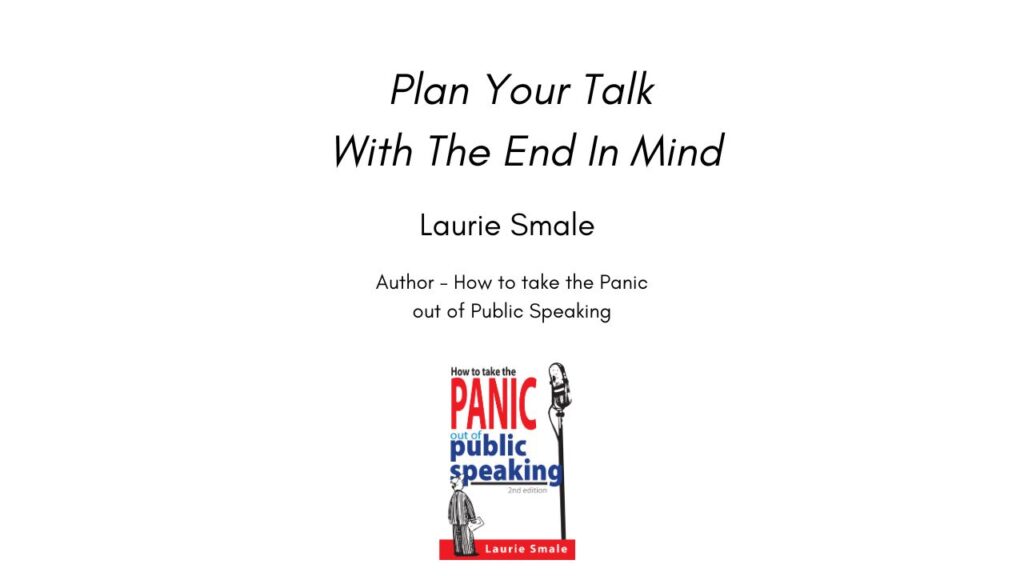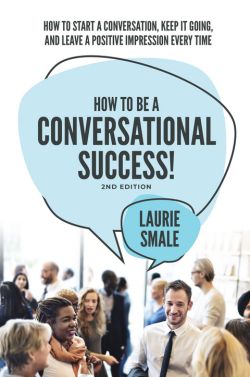Article Plan Your Talk With The End In Mind
We’ve all experienced the uncertainty of a speaker who has little idea of why they are there and where they want to take their listeners. Here’s how to avoid this awful predicament with Master Speech Coach and Inspirational Speaker Laurie Smale.
1. Get to the heart of the matter: When planning a talk we often waste a lot of precious time and energy worrying about how we are going to start it, when what we should be doing first is establishing a very clear idea of where we want our listeners to end up. So we’ve got to spend a little time formulating what I call a ‘focus sentence’, a statement that embodies the essence of our message and conclusion.
For example not long back I gave a talk entitled “How to beat the nerves in a business presentation” and the first thing I did as part of my planning was write out my ‘focus sentence’ along the lines: I want to show these people how to replace their fear of speaking before groups with the firm belief that they now know What to say and How to say it with Confidence!
I now had a clear beacon that showed the way to where I wanted to take my listeners and what examples to use in the body of my talk to lead them there. And when we arrived at our destination all I had to do was echo the sentiments embodied in my ‘focus sentence’ for an ending that was crisp, deliberate and meant something.
Not long back during a rehearsal break of an amateur play I was in, a young university student confided in me, “I can’t concentrate tonight. I’m struggling with an essay I’ve got to hand in tomorrow and I don’t know how to conclude it.” I walked him over to a quiet corner explaining that I’m in the business of helping people communicate more effectively.
I asked him if what he had written addressed the lecturer’s question. “I think so” he replied. “Well based on what you’ve written and the message you’re trying to get across… off the top of your head what exactly is it that you want to say? The overall point you want to make?”
Without thinking too deeply Robert gave me a wonderfully concise response. “There’s your conclusion… write it down now!” So we grabbed a piece of paper and did just that. I told him that when he got home to quickly revise what he had written and weave his last paragraph around this central sentence or let it stand alone.
Robert was absolutely thrilled that such a simple solution could so decisively solve a problem that had dogged him for years – how to conclude an essay. And this principle of boiling your main argument down to a single ‘focus sentence’ – before you start – in order to encapsulate your main message and conclusion, works the same when planning a public presentation.
2. Establish a clear structure with a focus sentence To be clear and to the point with your talk you’ve got to have a clearly defined path with interesting points along the way, all leading to a precise destination of where you intend taking your listeners. Do you want to inform them, persuade them, or entertain them – or a combination of these?
What do you want them to be thinking, feeling, acting upon when you step down from the platform?
If you haven’t got a crystal clear idea of where you’re heading, you’ll sure as eggs lose your audience along the way. Cicero, the famous Roman orator knew the importance of this when he said, “Before beginning, prepare carefully.” Wise advice.
Stephen Covey refines this somewhat when he says, “Always begin with the end in mind.”
A young playwright once said to Leonard Bernstein. “I have a fantastic idea for a stage play.” Bernstein replied: “I would love to hear it – write it down on the back of your business card and give it to me.” Astonished the young man said, “I can’t possibly put the whole idea on the back of a business card.” Bernstein replied: “Then you don’t have a valuable concept.” Your ‘focus sentence’ is exactly the same.
3. Prepare a destination for your audience Spend time reflecting on who your audience are, why they are there, their possible frame of mind and the precise message you want to get across to them. Now you’re ready to reduce this message down to your single ‘focus sentence’ for that audience. This single operation will cut heaps off your preparation time, for with this one stroke, you will have formulated both your conclusion and the destination of where you want to take your listeners.
And as Robert discovered, all you have to do at the end of your talk is echo the central idea of your ‘focus sentence’ for it encapsulates the heart of what you want to say. You’ll now have a crisp, clear, deliberate ending that ads impact to your presentation and ties it all together. Makes sense doesn’t it.
Extra Tip: Narrow your focus to give this specific audience what they want. Ask yourself: What motivates these people to be here? What are their needs, their desires and achievements? Keep the responses of these questions foremost in your mind as you formulate your talk to achieve the purpose embodied in your ‘focus sentence’.
These tried-and-proven public speaking tips reflect the exciting outcomes embodied in my second edition best-selling classic book, ‘How to take the Panic out of Public Speaking.’

© Laurie Smale Inspirational Speaker, Speaking Coach, and Author
ARTICLE // Plan Your Talk With The End In Mind
By Laurie Smale, Author, How to take the panic out of public speaking 🎤
- Get to the heart of the matter
- Establish a clear structure with a focus sentence
- Prepare a destination for your audience
Read all the details at https://lauriesmale.com/blog/article-plan-your-talk-with-the-end-in-mind
All of my practical coaching wisdom is in my three books available at https://lauriesmale.com/books
#lauriesmale #article #howtotakethepanicoutofpublicspeakingbook #publicspeaking #rehearsingyourtalk
Shared Online Archive.org Facebook Page Facebook Profile Google LinkedIn Page LinkedIn Profile Twitter / X








